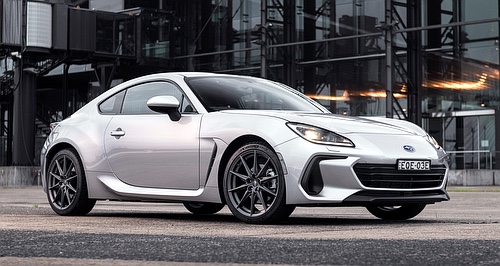Make / Model Search
News - Market Insight - Market Insight 2022Sportscars slip but new BRZ buoys segmentBox fresh: Initial deliveries of the second-generation Subaru BRZ have helped shore up a slumping sportscar segment. Online debut of the new-gen Subaru BRZ boosts model sales by almost 100 per cent YTDGallery Click to see larger images 9 May 2022 By NEIL DOWLING THE odd thing about the sportscar segment in Australia is that despite the relatively low volume of vehicles from that genre visible on the roads, it is a huge category bettered only by the SUV brands.
By category, sportscars comprise 39 models – more than all the small-car models – represented across three price bands.
Prices run from the cheapest at $32,180 (plus on-road costs) for the outgoing Toyota 86 GT, through to the Lamborghini Aventador SVJ at $949,640 + ORC.
But despite the choice, in year-to-date sales to the end of April this year the sector sold a relatively modest 2559 units in the four months, down 28.8 per cent on the same time last year.
Like most vehicle brands, the sportscar companies were hit by component shortages. But as in previous years, it is receiving competition from performance models in the form of sedans and SUVs, so the preserve of the sportscar – performance – is being challenged in vehicles that offer other benefits including more occupant space and perceived safety.
Australia’s best-selling sportscar so far this year is the Ford Mustang, with its 521 sales to date eclipsing the recent launch surge of the Subaru BRZ with its 325 new owners.
The BRZ was followed by the BMW 4 Series and 2 Series coupes and convertibles, with 265 and 229 sales respectively.
Highlights of the four months was the 99.4 per cent increase in sales of the BRZ as the new-gen model was released via online sales. Sales were up 99.4 per cent on the first four months of last year – a time when the BRZ was being wound down ready for the incoming replacement.
The BMW Z4, which shares much with the Toyota Supra, also drew more buyers than last year to show a 66.7 per cent sales increase with 40 units sold. By comparison, the Supra sold 57 cars, down 24 per cent on last year.
BMW also scored well with its 2 Series coupe and convertible models up 10.1 per cent (229 sales) and the 8 Series up 120 per cent with 22 sales.
Some models showed high percentage gains but only a handful of sales, such as the Maserati coupes and convertibles with a 500 per cent improvement and six sales.
Nissan sold seven last-of-the-line Nissan GT-R models for a 75 per cent improvement, the Lotus Elise sold 16 units for a 166.7 per cent increase and the Lexus LC found 14 new buyers for a 40 per cent sales increase.
With Lotus, much of the attention on the marque focuses around its last petrol-fuelled cars before the brand goes all-electric.
Its Exige also sold well, with 42 buyers to represent a 200 per cent increase over last year.
Many buyers want to retain an example of the brand’s last vehicles before the step away from petrol, perhaps with an eye on strong future resale value.
GMSV’s Chevrolet Corvette Stingray sold 68 units in its first four months to auger well for the model in the future. It will also attract attention as a race track campaigner to further boost sales.
The Porsche 911 sold 157 cars in the four months, up 29.8 per cent, while in other exotics, Ferrari sold 72 cars for a 10.8 per cent increase.  |
Click to shareMarket Insight articlesResearch Market Insight Motor industry news |










Facebook Twitter Instagram